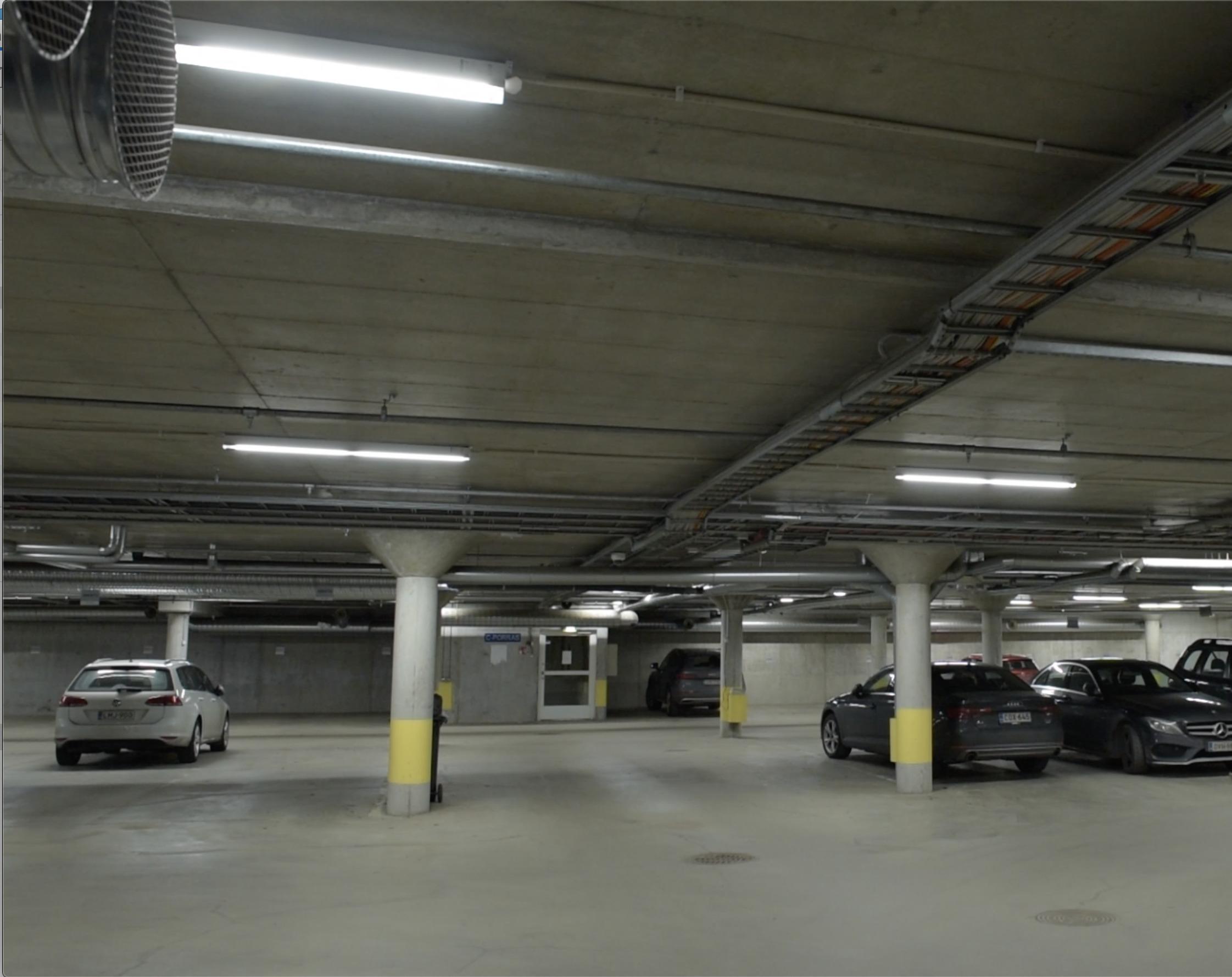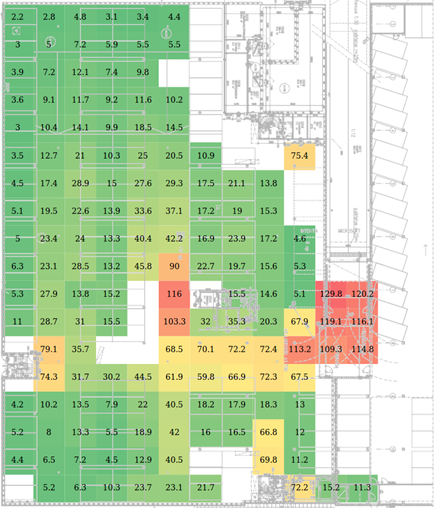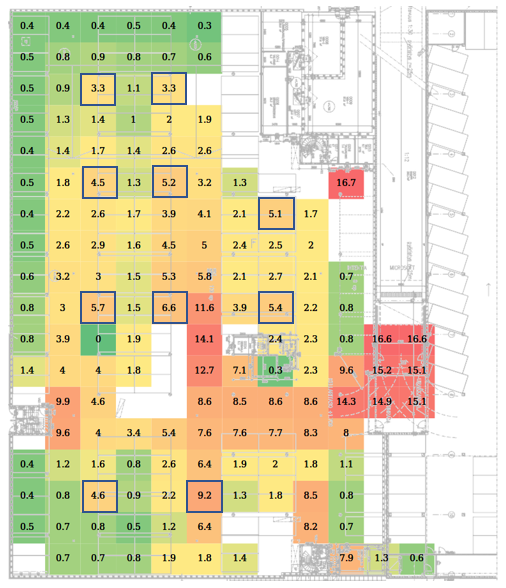ActiveAhead in the Helvar garage
A quick garage lighting upgrade for a quality result
In 2019, the parking garage in Keilaranta 5, Espoo Finland, was renewed by changing to new luminaires using the Helvar ActiveAhead system. The purpose of the project was to improve energy efficiency and user comfort.
 The Helvar garage in Espoo, Finland.
The Helvar garage in Espoo, Finland.
The challenge
Before the lighting renovation, the parking garage was fitted with fluorescent light sources (2 x 36W T8 tubes). These T8 tubes were driven by old magnetic ballasts consuming an additional power of up to 18W. Therefore, the power consumption per luminaire was 90W (2x 36W + 18W). There was a total of 325 luminaires that added up to a total of 29.3 kW. Using time scheduling, the lighting was controlled to be on for 12 hours per day, six days of the week. In addition, part of the garage was turned on outside of these hours by a movement detection sensor. This resulted in the annual consumption being altogether approximately 110,000 kWh. Initially, entering parts of the garage early in the morning or late at night, there would be no light. During Summer 2018, an interview was carried out to identify the views of garage users. Users were asked about the lighting conditions, its functionality, and the evaluation of energy consumption. A total of 26 responses were received stating that the lighting was inadequate, insecure and with energy consumption valued highly.
Transitioning to wireless
Helvar’s self-learning ActiveAhead lighting control system was chosen for the parking garage lighting renovation. ActiveAhead offers the benefits of LEDluminaires, is easy to install, offers very short downtime, doesn’t require time scheduling, and provides energy efficiency through movement sensors in every luminaire.
Once the renovation was complete, the project underwent an engineering research study instructed by Metropolia University of Applied Sciences to identify the effect of the self-learning ActiveAhead control system on lighting energy consumption instead of previous estimates. The study showed that the ActiveAhead system saves a great deal of energy. At the study site, energy consumption was about one-eighth compared to old fluorescent lighting. For comparison, when switched via time clock, standard LED luminaires would have consumed more than three times more electricity than luminaires fitted with ActiveAhead.
With the installation of ActiveAhead, the parking garage benefits from good quality lighting with the lights automatically switching on when the user enters the garage either by driving or walking. Lights are grouped to provide visibility further along the driveways and provide a feeling of safety. Furthermore, lights near the car and pedestrian entrances were set to never fully turn off but to dim down to 15 % when unoccupied to save energy while offering light when entering the garage. With presence detection, substantial energy savings are achieved. The estimated energy consumption calculated for the renovation was 28,000 kWh. The actual consumption was close to half of that, with the measured energy consumed with the ActiveAhead solution at 15,000 kWh. The measurements were done on a luminaire level. A heatmap representation was drawn which also highlights how much different areas of the garage were used.
The payback time of the new solution compared to changing the fluorescent tubes and washing the luminaires in this parking garage is 3.1 years. As a result of the lighting renovation, the parking garage achieved over 85% of energy savings (15,000kWh/110,000kWh = 86.4% savings). Moreover, the energy-saving of the installed ActiveAhead luminaires compared to LED luminaires with time scheduling is over 70%.
Figure 1: Cumulative energy consumption in kWh after 9 months on luminaire level for part of the parking garage
Ready for additional optimisation
The study also tested and simulated the impact of different configurations on energy consumption. The results highlighted that the ActiveAhead solution offers excellent tools to optimise comfort and energy consumption. Tested configuration was a distributed group around the garage linked to the entrance areas using corridor hold links. This resulted in increased comfort because there was light across the garage but relatively little energy consumption, as indicated by Figure 2. Simulations were done to calculate the impact of different light output levels and timeout parameters on energy consumption. For example, in this parking garage one-minute shorter Occupied timeout would save 5-12 % of energy.
Figure 2: Impact of a distributed corridor hold group to the energy consumption. Measurement period one month.
Interested in learning more about our ActiveAhead solution?
We respect your privacy
We use cookies to optimise our website and our service, to analyse site usage, and to assist in our marketing efforts. Read more and view used cookies in our Cookie Policy.
Functional Always active
The technical storage or access is strictly necessary for the legitimate purpose of enabling the use of a specific service explicitly requested by the subscriber or user, or for the sole purpose of carrying out the transmission of a communication over an electronic communications network.
Preferences
The technical storage or access is necessary for the legitimate purpose of storing preferences that are not requested by the subscriber or user.
Statistics
The technical storage or access that is used exclusively for statistical purposes.
The technical storage or access that is used exclusively for anonymous statistical purposes. Without a subpoena, voluntary compliance on the part of your Internet Service Provider, or additional records from a third party, information stored or retrieved for this purpose alone cannot usually be used to identify you.
Marketing
The technical storage or access is required to create user profiles to send advertising, or to track the user on a website or across several websites for similar marketing purposes.

